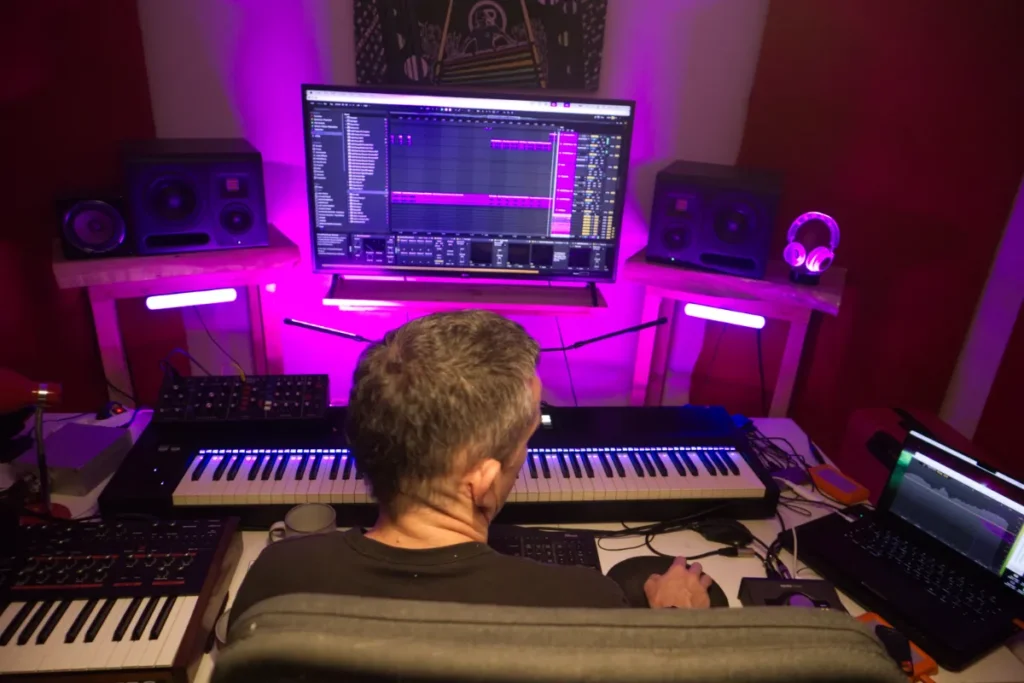Whether you’re crafting a bass-heavy Drum & Bass banger, weaving hypnotic House loops, or sculpting a Techno groove ready for the dancefloor, one thing’s for sure: your monitoring setup is mission-critical.
It’s the lens through which you perceive your music, and if that lens is distorted, you’re essentially producing blindfolded.
Think of it this way: if you can’t trust what you’re hearing, how can you possibly make confident mixing decisions?
In this guide, we’ll dissect the key differences between studio monitors, headphones, and room treatment, exploring how each impacts your ability to craft killer tracks – regardless of whether you’re in a professional studio or a bedroom sanctuary.
Why Monitoring Matters (More Than You Think)
Monitoring is your window into the sonic world you’re creating. A flawed setup can make pristine mixes sound muddy, or worse, trick you into fixing problems that only exist within your listening environment, not in your track itself.
When your monitoring isn’t on point, you might:
- Over or under-EQ certain frequencies.
- End up with bass that disappears on other systems.
- Create a stereo image that collapses when played elsewhere.
- Produce tracks that sound wildly inconsistent across different playback devices – from clubs to cars to headphones.
The good news? You can fix this! It starts with understanding the strengths and weaknesses of each component in your setup and recognizing where they might be leading you astray.
Studio Monitors: The Gold Standard (with a Catch)
Studio monitors are designed to provide a flat, accurate representation of your mix. They offer a physical, open-air listening experience that’s hard to replicate.
The Good:
- A well-treated room provides a natural and accurate stereo image.
- You can feel the low-end frequencies, not just hear them.
- Reduced ear fatigue during long sessions.
The Bad (and often overlooked):
- In an untreated room, reflections from walls and furniture muddy the sound.
- Bass frequencies can become unpredictable, with certain notes disappearing while others boom uncontrollably (room modes).
- You might perceive sonic issues that aren’t actually present in your mix, or miss crucial details altogether.
Key Takeaway: Monitors are powerful tools, but their performance is heavily dependent on your room’s acoustics. Without proper treatment, they can be deceiving.
Headphones: Precision and Portability Unleashed
High-quality headphones offer a reliable alternative, especially in untreated environments. By bypassing the room’s acoustics altogether, you gain a direct line to your audio.
The Perks:
- Exceptional detail and clarity.
- Zero room interference.
- Perfect for late-night sessions or on-the-go production.
The Drawbacks:
- Lack of physical sensation, especially in the low end.
- The stereo image can feel unnaturally wide or exaggerated.
- Extended headphone use can lead to ear fatigue and skewed sonic judgment.
Headphones excel at surgical tasks like editing, sound design, and critical listening for specific issues. However, relying solely on headphones for mixing and mastering can be risky.
Pro Tip: Use headphones to identify clicks, harsh frequencies, and phase issues. But always cross-reference your mix on other systems!
Room Treatment: The Silent Game-Changer
You don’t need a fancy, expensive mastering suite to achieve accurate monitoring. Even basic acoustic treatment can drastically improve your listening environment.
Treatment Benefits:
- Tames unwanted reflections and flutter echoes.
- Improves the clarity and definition of low frequencies.
- Tightens and focuses the stereo image.
Where to Start:
- First Reflection Points: Treat the side walls and ceiling at the points where sound first reflects from your speakers to your ears.
- Bass Traps: Place bass traps in the corners of your room to absorb low-frequency build-up.
- Floor Reflection: A rug or carpet can help reduce reflections from the floor.
Even DIY solutions like rockwool panels or foam tiles are far better than no treatment at all.
Important Note: Don’t confuse acoustic treatment with soundproofing. Treatment focuses on controlling reflections within your room, while soundproofing aims to block sound from entering or exiting the room.
The Hybrid Approach: The Best of Both Worlds
Want the honest truth? No single monitoring setup is perfect. That’s why most professional producers adopt a hybrid approach.
The strategy:
- Mix primarily on monitors: Utilize your studio monitors in a treated room (if possible) as your primary mixing source.
- Cross-reference on headphones: Use headphones to check for detail, clarity, and specific issues.
- Test in multiple contexts: Listen to your track in your car, on your phone, through a club sound system – anywhere and everywhere you can.
This comprehensive approach provides valuable perspective, preventing you from making critical decisions based on the limitations of a single monitoring system.
Conclusion: Know Your Setup, Trust Your Ears
The gear you use definitely matters. But understanding how your setup influences your perception of sound is what separates a good producer from a great one.
Whether you’re rocking budget headphones or top-of-the-line monitors, the key is consistency and awareness. Learn the nuances of your tools, understand the characteristics of your listening space, and always reference your mix in the real world.
Happy producing!


